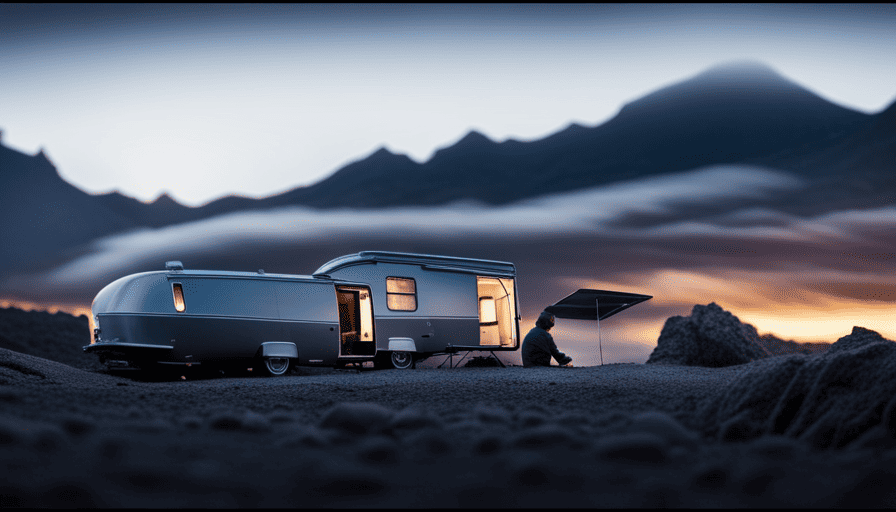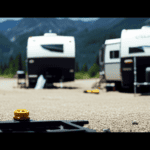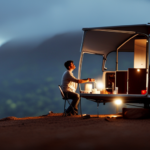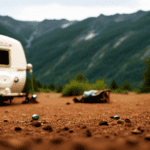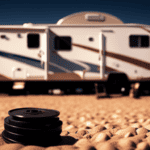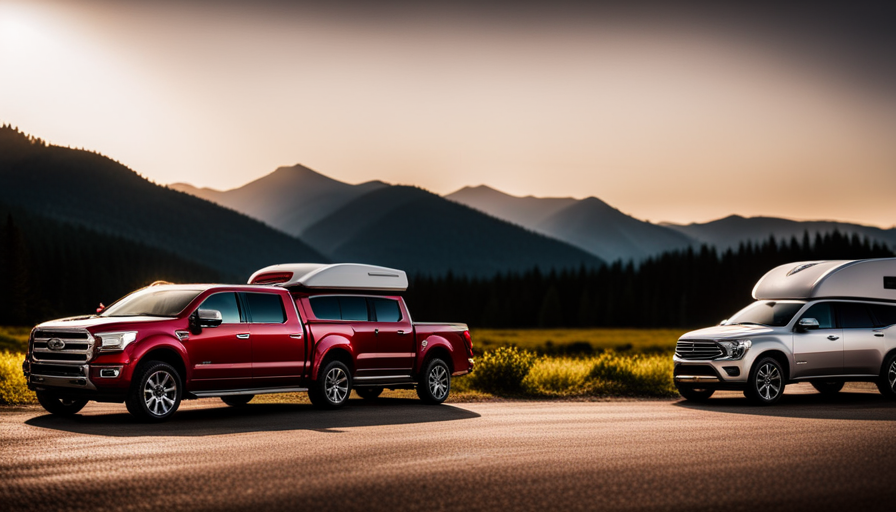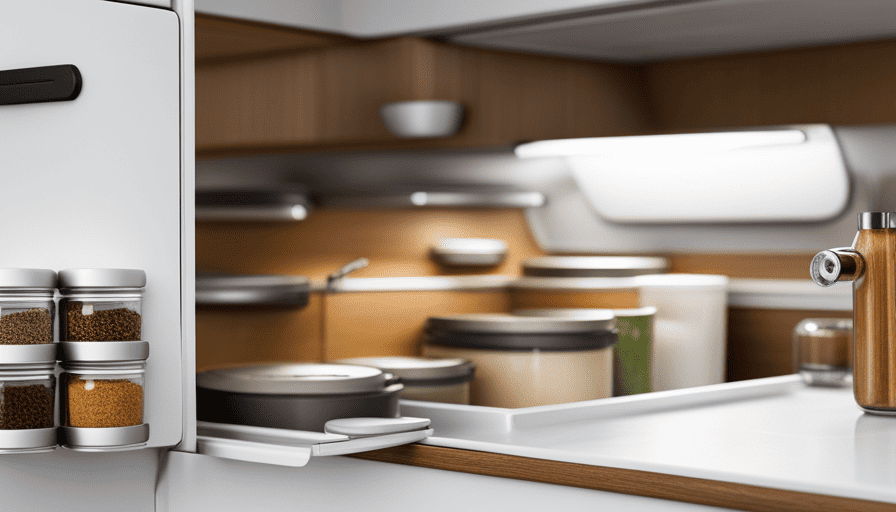Imagine setting up a campsite in a picturesque location, surrounded by the beauty of nature. As you step inside your RV, you realize that it is not level.
The feeling of imbalance and instability can be quite unsettling, not to mention the potential damage it can cause to your camper. But fear not, for I have the solution to your leveling woes.
In this article, I will guide you through the process of leveling your camper with precision and ease. By following these step-by-step instructions, you’ll be able to ensure a stable and secure camping experience.
So grab your tools, find a flat surface, and let’s get started on achieving that perfect balance for your camper. Get ready to enjoy the serenity of your campsite, knowing that your camper is securely leveled and ready for your adventures ahead.
Key Takeaways
- Properly leveling a camper is important to prevent imbalance, instability, and potential damage to the camper.
- The use of leveling blocks or ramps can help achieve a level surface for the camper.
- It is important to assess the current level of the camper, check weight distribution and tire wear, and park on a flat surface before leveling.
- Care should be taken when driving onto blocks or ramps, ensuring a gradual and smooth transition, and checking the stability of the camper and blocks/ramps.
Assess the current level of your camper
Before you start leveling your camper, it’s important to assess its current level to determine how much work needs to be done. Assessing the weight distribution of your camper is crucial for ensuring safety while on the road. Uneven weight distribution can lead to instability, which can be dangerous when driving or parking your camper.
Start by checking the balance of your camper using a level tool. Place it on the floor inside the camper and see if it indicates any significant slopes. Pay attention to the areas where the weight is concentrated, such as the kitchen or bathroom, as these can affect the overall balance.
Additionally, inspect the tires for any signs of uneven wear, as this can also indicate an imbalance. Once you have assessed the current level of your camper and identified any issues, you can move on to determining the necessary tools and equipment needed to level it properly.
Determine the necessary tools and equipment
Once you’ve gathered all the essential gear, it’s time to bring out the secret weapons for creating a stable and balanced haven on wheels. To properly level your camper, you’ll need a few tools and equipment.
Here is a list of items that will help you achieve a perfectly level camper:
-
Leveling blocks: These blocks are designed to provide additional height and stability to your camper. They can be stacked and positioned under the wheels to raise or lower specific areas of the camper.
-
Bubble level: This tool is essential for accurate leveling. It can be placed on a countertop or any flat surface inside your camper to ensure that it’s perfectly level.
-
Jacks: Sturdy jacks are necessary to provide support and stability. They can be used to lift specific areas of the camper and adjust its height.
-
Chocks: Chocks are used to prevent your camper from rolling or moving while it’s being leveled. They can be placed behind the wheels to keep them in place.
By utilizing these tools and equipment, you’ll be able to employ various leveling techniques to achieve the desired balance and stability for your camper. Once your tools are ready, the next step is to park your camper on a flat surface and begin the leveling process.
Park your camper on a flat surface
Find a nice, even spot to park your cozy home-on-wheels and prepare for a smooth and enjoyable camping experience. When it comes to leveling your camper, parking it on a flat surface is crucial. This ensures stability and prevents any discomfort inside the camper. Common leveling mistakes include relying solely on your camper’s built-in leveling system, which may not always be accurate. It is advisable to use a level tool to double-check the camper’s position. Additionally, avoid parking on an incline, as this can cause the camper to tilt and potentially lead to damage.
To illustrate the importance of parking on a flat surface, consider the following table:
| Flat Surface | Tilted Surface | Result |
|---|---|---|
| Stable and secure | Unbalanced and shaky | Comfortable and safe |
| Even weight | Uneven weight | Proper functioning of appliances and utilities |
| Minimal stress | Increased stress | Longevity of camper’s structure and components |
| Smooth experience | Uneven experience | Enjoyable camping trip |
| Reduced risk | Higher risk of damage | Peace of mind |
By parking on a flat surface, you prevent common leveling mistakes and ensure a stable and safe camping experience. In the next section, we will explore the use of leveling blocks or ramps to further enhance the leveling process.
Use leveling blocks or ramps
Using leveling blocks or ramps can give your camper a solid foundation, like building a sturdy house on a rock. These alternative leveling methods are essential for ensuring stability and comfort while camping. Let’s explore the pros and cons of using leveling blocks versus ramps.
Leveling blocks offer versatility and adjustability. They’re typically made of durable materials, such as plastic or wood, and can be stacked to achieve the desired height. This allows for precise leveling on uneven surfaces. However, leveling blocks can be time-consuming to set up and may require additional tools for proper alignment.
On the other hand, ramps offer a quick and convenient leveling solution. They’re usually made of sturdy materials like heavy-duty plastic or metal. Ramps provide a gradual incline, making it easier to drive your camper onto them. However, ramps may not be suitable for extremely uneven terrain and may have weight limitations.
To position the blocks or ramps under the wheels, make sure they’re placed evenly and securely. This’ll prevent any unwanted movement or shifting while you’re inside the camper.
Position the blocks or ramps under the wheels
Place the blocks or ramps securely under your wheels to ensure a stable and comfortable camping experience. Using a leveling system is crucial to prevent camper damage and create a level surface inside your camper. By positioning the blocks or ramps correctly, you can achieve a balanced camper that eliminates any potential rocking or tilting.
To help you visualize the proper placement of blocks or ramps, refer to the table below:
| Wheel Position | Block/Ramp Placement |
|---|---|
| Front Left | In front of the wheel |
| Front Right | In front of the wheel |
| Rear Left | Behind the wheel |
| Rear Right | Behind the wheel |
| Spare Tire | Not applicable |
Ensure that the blocks or ramps are placed securely and snugly against the tires. This will prevent any movement or shifting when you drive onto them. Check that the blocks or ramps are level and parallel to the ground, as this will provide maximum stability for your camper.
With the blocks or ramps in place, slowly drive onto them, ensuring that all wheels are evenly supported. This gradual approach will prevent any sudden jolts or damage to your camper. Transitioning smoothly onto the blocks or ramps will set the stage for the next step in leveling your camper.
Slowly drive onto the blocks or ramps
Gently ease your wheels onto the blocks or ramps, as if floating onto a cloud, ensuring a smooth and stable transition. When leveling your camper, the way you drive onto the blocks or ramps is crucial to achieving a level surface.
To begin, position the blocks or ramps in front of your wheels, making sure they’re aligned with your tires. Slowly drive forward, using gentle and controlled acceleration. Apply slight pressure on the gas pedal to maintain a steady pace. As you approach the blocks or ramps, keep your eyes focused on the road ahead, ensuring that your wheels are centered on the blocks or ramps.
Be cautious not to drive too fast, as this may cause your camper to shift abruptly, compromising stability. Additionally, be aware of alternative leveling methods, such as using leveling jacks or hydraulic systems that automatically level the camper. These techniques offer convenience and precision, minimizing the need for manual adjustments.
As you drive onto the blocks or ramps, you’ll want to ensure that your camper is level. To check the level, use a bubble level or smartphone app, which’ll provide accurate measurements and guide you in making any necessary adjustments.
Check the level using a bubble level or smartphone app
Picture yourself on your camping adventure, pulling out your smartphone and opening up a bubble level app to ensure your setup is perfectly balanced. Using a bubble level or smartphone app, checking the level of your camper is a crucial step in achieving stability and comfort during your trip.
Here’s how you can do it:
- Place your smartphone on a stable surface inside your camper.
- Open the bubble level app and calibrate it according to the on-screen instructions.
- Carefully position your smartphone on different areas of the camper floor to assess the levelness.
- Observe the bubble on the app’s screen and make adjustments accordingly.
This process may seem simple, but it plays a significant role in preventing uncomfortable sleeping positions, water pooling, or appliances not functioning correctly. Ensuring your camper is level will enhance your overall experience and enjoyment.
Now that you have checked the level using a bubble level or smartphone app, it’s time to move on to the next step: adjusting the blocks or ramps as needed. By doing so, you’ll be able to achieve the perfect balance for your camper and make your camping experience even more enjoyable.
Adjust the blocks or ramps as needed
Once you’ve determined the levelness, it’s time to make necessary adjustments to the blocks or ramps for optimal stability.
Using alternative methods such as wooden blocks or leveling ramps, you can ensure the safety of your camper. Begin by placing the blocks or ramps in the appropriate locations under the wheels or stabilizing jacks. Pay close attention to the level indicator and make adjustments as needed.
If one side of the camper is higher than the other, add blocks or raise the ramp on the lower side until the camper is level. It’s important to ensure that all blocks or ramps are secure and in contact with the ground to prevent any shifting or movement. Double-check the levelness using the bubble level or smartphone app before proceeding.
Once you’re satisfied with the adjustments, test the stability of your camper by gently rocking it back and forth. If it remains stable, you can proceed with setting up camp.
Transitioning into the next section, it’s important to test the stability of your camper before fully settling in.
Test the stability of your camper
Try testing the stability of your setup by gently giving it a gentle shake to make sure everything’s secure. This is an important step in the leveling process as it allows you to identify any potential issues that could compromise the stability of your camper.
Start by checking the stability of the blocks or ramps that you’ve used to level your camper. Make sure they’re firmly in place and not shifting or moving when the camper’s shaken.
Additionally, inspect the camper itself for any signs of instability, like loose fittings or components.
To accurately test the stability of your camper, you may need specific equipment, like a level or a stabilizer jack. A level’ll help you determine if your camper’s sitting evenly on the blocks or ramps, while a stabilizer jack can provide additional support and stability. By using these leveling techniques, you can ensure that your camper’s safe and secure during your camping experience.
Once you’ve tested the stability of your camper, you can make any additional adjustments to ensure a level surface. This may involve adding more blocks or ramps, or adjusting the position of the existing ones. It’s important to have a level surface to prevent any discomfort or issues while inside the camper.
Make any additional adjustments to ensure a level surface
To ensure a stable and comfortable experience, be sure to fine-tune the positioning of your blocks or ramps for an even surface inside your camper. This step is crucial in achieving proper leveling and preventing any discomfort or accidents while inside the camper.
Here are some additional leveling techniques to consider:
-
Double-check the position of the blocks or ramps: Ensure that they’re properly aligned with the wheels of your camper. It’s important to have a solid foundation to avoid any shifting or sliding.
-
Use leveling bubbles: These small, circular devices can be placed on a flat surface inside your camper to check for any remaining imbalances. Adjust the blocks or ramps accordingly until the bubbles indicate a level position.
Troubleshooting common leveling issues:
-
Uneven terrain: If you’re camping on uneven ground, it may be challenging to achieve perfect leveling. In such cases, consider using additional blocks or ramps to compensate for the unevenness.
-
Weight distribution: Uneven weight distribution inside the camper can affect its stability. Ensure that heavy items are evenly distributed to avoid any tilting or imbalance.
By following these additional leveling techniques and troubleshooting common leveling issues, you can create a level surface inside your camper, ensuring a safe and comfortable camping experience.
Frequently Asked Questions
How do I assess the current level of my camper?
Assessing the current level of my camper requires a systematic approach. I employ camper leveling techniques, which act as my guiding compass.
As an allegory, I liken this process to climbing a mountain. I begin by evaluating the foundation, checking for any signs of imbalance or instability.
Next, I examine the structural components, ensuring they’re aligned and functioning optimally.
Finally, I assess the overall weight distribution, adjusting as necessary to achieve a level and safe camper experience.
What tools and equipment do I need to level a camper?
To level a camper, you’ll need a few essential tools and equipment. Firstly, a leveling device such as a bubble level or an electronic leveling system is crucial for assessing alignment.
Additionally, you’ll need leveling blocks or ramps to adjust the height of your camper. It’s important to ensure proper weight distribution, so having a tongue jack and wheel chocks can be helpful.
Lastly, a sturdy stabilizing system will help maintain stability once the camper is leveled.
How do I test the stability of my camper after leveling it?
Testing the stability of my camper is crucial for a safe and enjoyable camping experience. One sign of an unlevel camper is doors that don’t close properly, causing frustration and potential safety hazards.
To ensure stability, I use a bubble level and check that the camper is evenly balanced. I also inspect the tires for any signs of wear or damage. Additionally, I make sure all stabilizer jacks are securely in place to prevent any unwanted movement.
What are some additional adjustments I can make to ensure a level surface?
To ensure a level surface, there are alternative leveling methods you can consider. One option is using leveling blocks or ramps to raise the low side of the camper.
Another method is using a leveling app or device that helps you determine the exact levelness of your camper.
When leveling, it’s important to avoid common mistakes such as relying solely on the camper’s built-in level, ignoring the stability of the ground, or forgetting to check for any rocking or swaying after leveling.
Can I use a smartphone app to check the level of my camper?
Did you know that 95% of Americans own a smartphone? With the rise of technology, using a smartphone app for camper leveling is becoming a popular alternative method.
There are several pros and cons to consider when using a smartphone app. On the positive side, apps are convenient and easy to use. However, they may not always provide accurate readings and can drain your phone’s battery quickly.
It’s essential to weigh these factors before relying solely on a smartphone app for camper leveling.
Is There a Difference in Leveling Techniques for 5th Wheel Campers and Other Types of Campers?
Leveling a 5th wheel camper requires a specific technique compared to other types of campers. Since 5th wheel campers connect to the bed of a pickup truck, they need to be leveled front to back. Other campers, like travel trailers and pop-up campers, are typically leveled side to side. To ensure stability and prevent any rocking, it is important to follow the right leveling technique for your specific camper type.
Conclusion
Well, there you have it, folks. The ultimate guide to leveling your camper! By following these simple steps, you can ensure that your camper is as stable as a rock, and you’ll feel like you’re sleeping on a cloud.
With just a few tools and a little bit of effort, you’ll be able to enjoy your camping trip without any worries about uneven surfaces. So go ahead, level that camper, and get ready for the most comfortable camping experience of your life!

